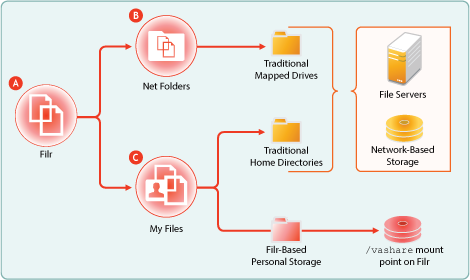3.6 Planning File and Folder Targets for Filr
IMPORTANT:We recommend that you review the information in the following to prepare for planning your Filr storage targets:
-
My Files (Personal Storage)
andNet Folders
in the How Filr Works–Overview Guide -
The following sections in the Novell Filr 1.1 Administration Guide:
3.6.1 Storage Target Overview
Figure 3-3 Potential File and Folder Targets for Filr

|
Letter |
Details |
|---|---|

|
Filr provides file access through
|

|
Net Folders point to file servers and/or network-based storage. |

|
My Files can also point to file servers and/or network-based storage when these include traditional home directories. If the Personal Storage feature is enabled, My Files also provides access to personal files and folders that are stored in Filr itself. |
3.6.2 Identifying File Servers and Network Storage Targets
-
On your worksheet, identify the file servers and network-based storage devices that Filr will provide access to.
For more information, see
Filr Server Requirements
in the Novell Filr 1.1 Installation and Configuration Guide. -
After you have recorded the information for each file server and network-based storage device, continue with
Planning Net Folder Servers.
3.6.3 Planning Net Folder Servers
-
For each server or other network-based storage device identified in the previous section, do the following:
-
Identify the NSS volumes and/or CIFS shares that Filr will provide access to.
-
On your worksheet in the Net Folder Servers section, assign a unique Net Folder Server Name for each volume and/or share.
Consider using a name that reflects the DNS and volume or share names associated with the Net Folder Server.
-
Identify a Net Folder Proxy User for each Net Folder Server and record the information on your worksheet.
-
-
After you have planned the Net Folder Servers that are associated with each file server/network-based storage device, continue with
Planning Net Folders.
3.6.4 Planning Net Folders
HINT:Consider using Novell File Reporter in planning for Filr. File Reporter helps you quickly determine the number, sizes, types, access frequency, and so on for your organization’s files.
-
For each non-home-directory Net Folder Server identified in
Planning Net Folder Servers,
do the following:-
Identify each main folder that contains files that require Filr access.
-
On your worksheet in the Net Folders section, assign names that reflect the purpose or content of each folder.
-
Record the Net Folder Server Name associated with each Net Folder.
-
Record the path from the Net Folder Server to each Net Folder.
-
For each Net Folder, record:
-
The number of files
-
The types of files, such as PDF, .doc, and so on
-
The size range
-
-
Assess or estimate how often file content changes within each Net Folder.
-
Assess how often user access rights change within each Net Folder.
This helps determine synchronization frequency.
-
Set a roll-out priority for each Net Folder.
Initially, you should enable only the highest priority files and folders for access through Filr, to ensure a controlled and smooth implementation.
The remaining files and folders can be enabled in a phased approach during the production rollout.
Consider creating a map of the file structure that shows the order in which folders will be enabled through the testing, pilot, and production deployments.
-
-
After you have planned the non-home Net Folders, continue with
Planning Net Folder Access.
3.6.5 Planning Net Folder Access
IMPORTANT:We recommend that you review the information in Access Rights and Filr
in the How Filr Works–Overview Guide to prepare for planning Filr user access.
Also see Configuring User Access to the Filr Site
in the Novell Filr 1.1 Administration Guide.
-
On your worksheet in the Net Folder Access section, record the following information for each Net Folder:
-
The Net Folder name
-
The names of each user and/or group that will be granted access to the Net Folder through Filr
-
The Filr Role for each user and/or group.
Filr roles are determined by file system rights and are not configurable in Filr.
-
Verify that each user and/or group has the file system rights for the role they are expected to fill.
For more information, see
Access Through Filr Involves One of Four Possible Roles
andRights to Files and Folders
in the How Filr Works–Overview Guide.
-
-
After you have planned for user and/or group access to each Net Folder, continue with
Planning Home Folder Access (My Files).
3.6.6 Planning Home Folder Access (My Files)
-
For each home directory Net Folder Server identified in
Planning Net Folder Servers,
do the following:-
On your worksheet in the My Files (Home Folder Net Folder Servers) section, assign a name for each Net Folder Server that is associated with a set of home folders.
-
For each home folder Net Folder Server, record:
-
The number of files
-
The types of files, such as PDF, .doc, and so on
-
The size range
-
-
Set a roll-out priority for each home folder Net Folder Server.
-
-
After you have planned the home Net Folders, continue with
Planning for Personal Storage (My Files).
3.6.7 Planning for Personal Storage (My Files)
-
If you are allowing users to have personal storage on Filr, then on your worksheet in the My Files (Personal Storage) section, record quotas for users and/or groups of users, whichever fits your organization’s needs.
-
After you have planned Personal Storage quotas, continue with
Planning for Content Searching (Content Indexing).